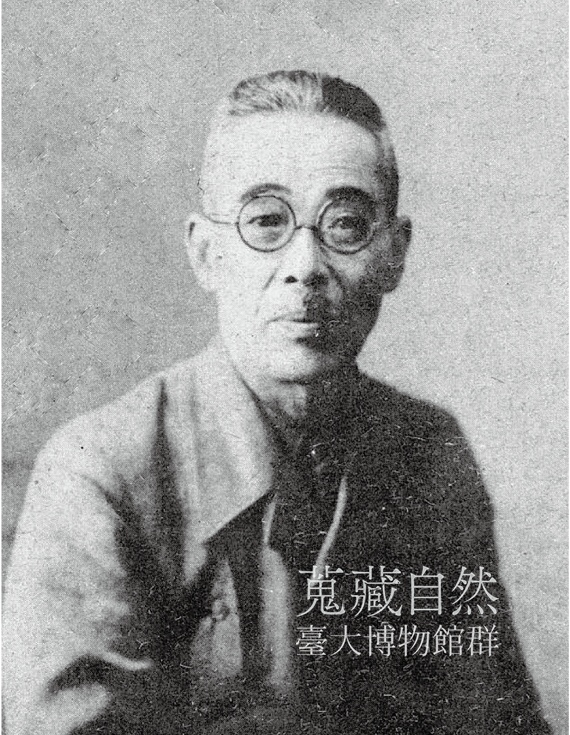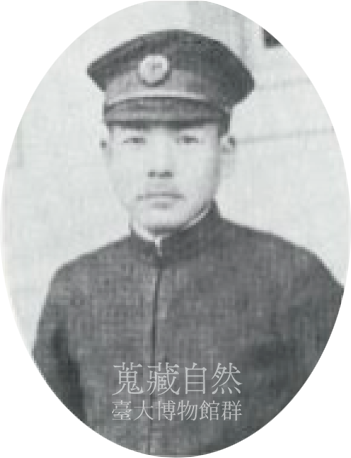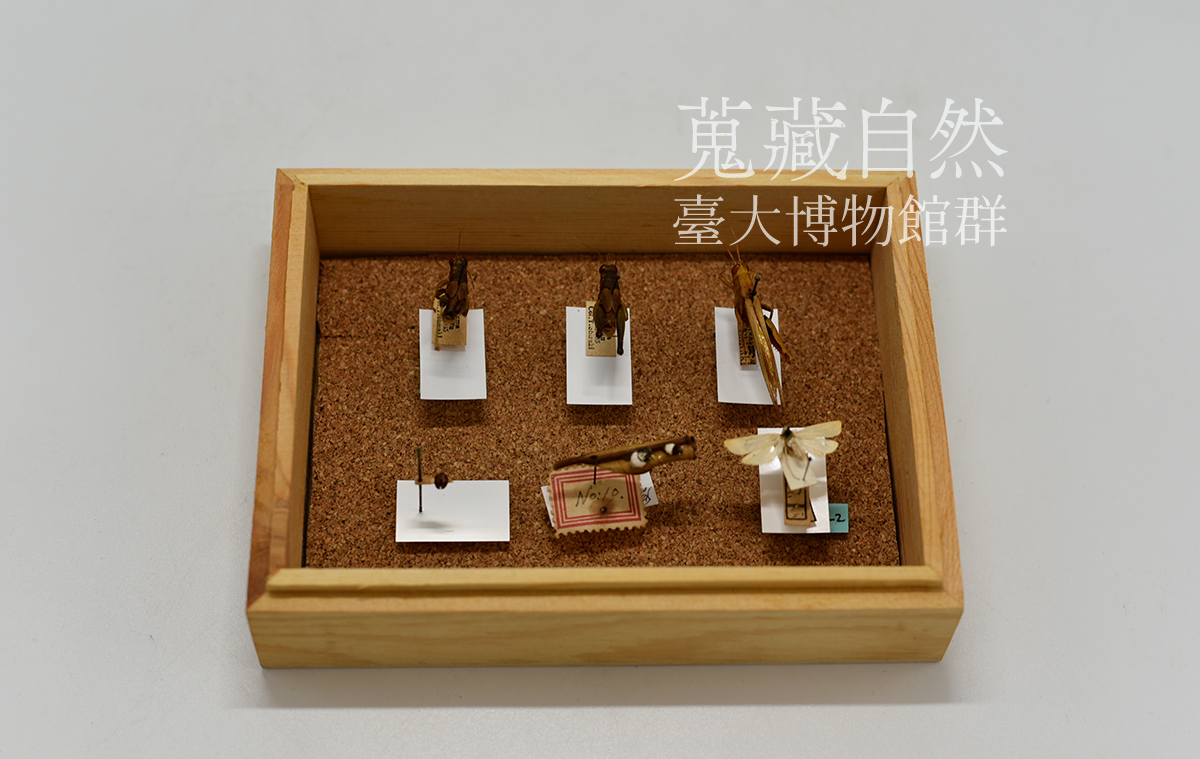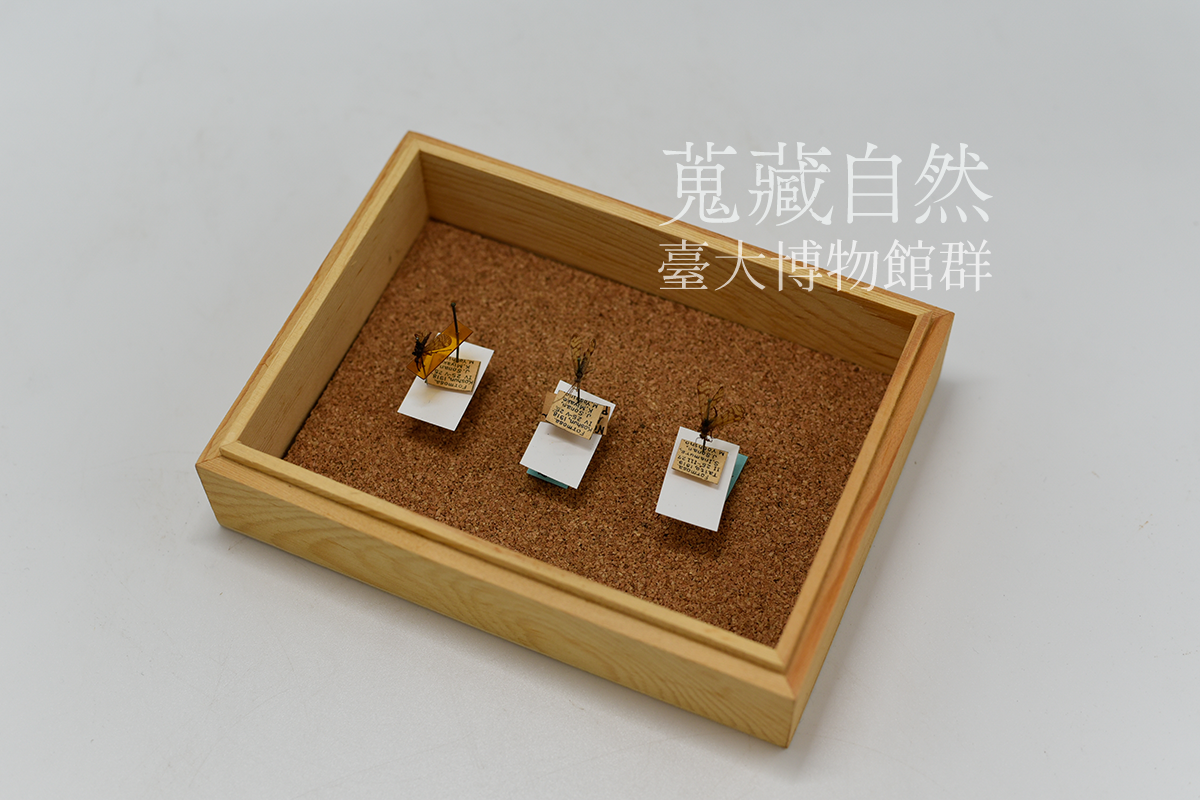昆蟲標本館NTU Insect Museum
本館創立於1936年,是目前國內昆蟲標本館中最具歷史意義的典藏資產之一,其中不乏百年以上之老標本與無數珍貴標本。本館標本蒐藏源自19世紀初期,除了典藏日治時代以及戰後的標本外,1980年開始,在國家科學委員會的支持下,昆蟲學系師生積極展開臺灣昆蟲相調查,使得昆蟲標本數量激增。本館蒐藏之標本超過33萬個體,依性質可概分為模式標本、研究標本、教學標本、展示標本4類。為推廣昆蟲學知識,本館於2007年加入博物館群並設置特展室。展示主題包括昆蟲館紀事、世界昆蟲區、寬尾鳳蝶的發現、保育類昆蟲區、民俗昆蟲及文化區、標本教育區、採集教育區、昆蟲生態區、教師主題區及多媒體互動區等。本館豐富又珍貴的昆蟲標本蒐藏,是臺灣昆蟲學發展重要的科學與文化資產。
Founded in 1936, the NTU Insect Museum is one of the most significant insect museums in Taiwan historically, housing century-old and countless other invaluable specimens. The earliest collection items date back to the early 19th century, while others are from the Japanese colonial period and after World War II. With the support of the National Science Council, faculty and students in the Department of Entomology at NTU started to conduct a panoramic investigation of insects in Taiwan in 1980, leading to a spike in the number of specimens. The museum boasts a staggering number of over 330,000 specimens classified into four categories according to their purposes: type specimen, research specimen, teaching specimen, and display specimen. To make entomology more accessible to the public, the museum joined the NTU Museums in 2007 and set up a special exhibition room. Exhibition content includes a chronology of the museum, insects of the world, discovery of the broad-tailed swallowtail butterfly, endangered insect species, insect customs and culture, specimen education, specimen collection, insect ecology, specialty subjects of faculty, and an interactive multimedia section. The rich and priceless insect collection in the museum will serve to be an important piece of cultural and scientific heritage in Taiwan’s entomology domain.

臺北帝國大學昆蟲學·養蠶學教室與中央研究所農業部 (林心嵐繪製)
Entomology and Sericulture Laboratory, Taihoku Imperial University and Ministry of Agriculture, Central Research Institute
臺北帝國大學昆蟲學·養蠶學講座教室座落於蟾蜍山下,地理位置十分特別,且距離校本部還有一段距離,原因是其特殊的歷史背景造就如此特別的現象。當年的講座教授素木得一又兼任中央研究所農業部應用動物科科長,遂特別在應用動物科建物東側建立其講座教室。
The Entomology and Sericulture Laboratory is located at the foot of Mt. Chanchu, with a very specific geographical location. It is some distance away from the main campus as a result of its historical background. The Chair Professor back at the time, Shiraki Tokuichi, also served as the head of the Division of Applied Zoology of the Ministry of Agriculture of the Central Research Institute. Therefore, the Laboratory was builded next to the Division of Applied Zoology.
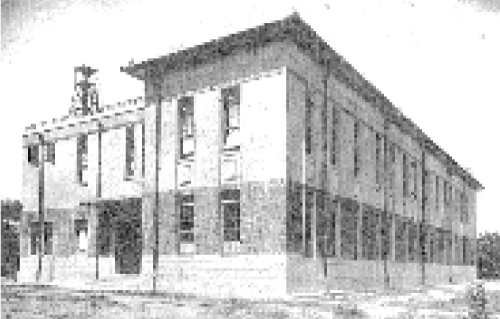
臺北帝國大學昆蟲學·養蠶學教室(出處:1936年,臺灣建築會誌第8輯第4號。)
Entomology and Sericulture Laboratory, Taihoku Imperial University
昆蟲館的歷史非常悠久,校舍內許多建築物件還未翻新,保留著濃厚歷史的韻味,昆蟲標本室及圖書室更是獨具特色。建築的外觀於臺北帝大建築群中比較異類的一棟,不像椰林大道上兩旁帝大時期建物主要採仿羅馬樣式,帶有點「現代主義特質」的建物,比較少裝飾性的設計。例如窗戶都是方形窗戶,沒有圓拱窗的設計,整體線條也比較水平垂直簡潔,甚至整個建築物捨棄對稱的設計。
The Entomology Building is rich in history. Many building pieces in it have not yet been renovated, which retain a strong sense of nostalgia. Among them, the Insect Museum and library truly stand out. The appearance of the building is quite different among the Taihoku Imperial University buildings. Unlike the Taihoku Imperial University buildings lining up on both sides of Royal Palm Boulevard which mostly adopt a Roman style, it has some “modernist characteristics” with fewer decorative designs. For example, the windows are all square ones as opposed to an arched design. Overall, the horizontal and vertical lines look relatively simple. The building’s design is asymmetrical.

昆蟲學·養蠶學教室裡的昆蟲標本室(出處:1936年,臺灣建築會誌第8輯第4號。)
Insect Specimen Room of the Entomology and Sericulture Laboratory
昆蟲標本室的設計是素木得一教授參考札幌農學校標本室設計,有靠著牆壁的標本櫃,並設計閣樓可供拿取放置高處的標本盒。早期典藏室的擺設是三面靠牆的標本櫃,中央有一檢視標本的長桌。由於典藏的昆蟲標本持續增加,現在的昆蟲標本室中央也擺置許多標本櫃。
The design of the insect specimen room is based on that of the specimen room of the Sapporo Agricultural College by Professor Shiraki Tokuichi. There are specimen cabinets against the wall, as well as an attic where specimen boxes are put in a high place. The specimen room from the early days was furnished with specimen cabinets against 3 walls, with a long table in the center for examining specimens. As the collection of insect specimens continues to grow, many specimen cabinets are also placed in the center of the insect specimen room.
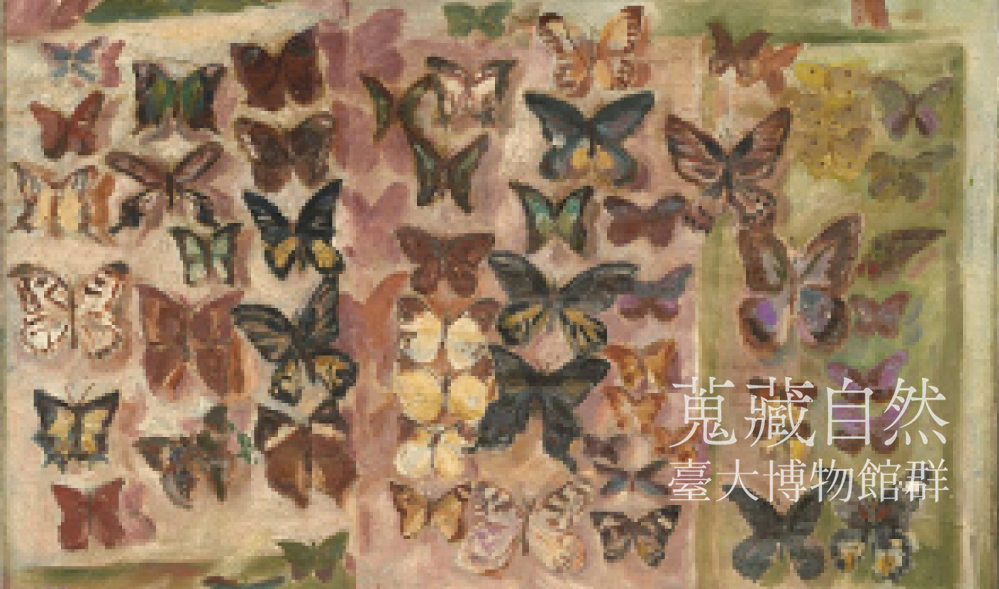
百蝶圖
One Hundred Butterflies
畫作的作者為素木洋一,為臺北帝國大學「昆蟲學.養蠶學」講座教授素木得一的兒子。此畫作可能為繪製昆蟲學家的父親工作的場景,使用他擅長的油畫作為媒材,繪畫的風格並非寫實,屬於別具風格的抽象感,但仍然可以從中辨識出一些蝴蝶的種類。例如左數第三排第三行為目前臺灣的保育類裳鳳蝶屬的鳳蝶。右下角為一對大鳳蝶,左為雄蝶右為雌蝶。
The painting is created by Shiraki Yoichi, the son of the Chair Professor of the Entomology and Sericulture Lecture, Taihoku Imperial University, Shiraki Tokuichi. This painting may depict a scene of the work of his father, who was an entomologist. He chose his specialty, oil paintings, as the medium. The style of the painting is not realistic, but has a unique sense of abstraction. However, one can still identify some butterfly species from it. For example, the third column in the third row from the left is a swallowtail butterfly from the protected Troides genus. In the lower right corner is a pair of Great Mormons, with the male on the left and female on the right.
臺北帝國大學.自然史研究
昆蟲相關人物小誌
People
素木得一
Shiraki Tokuichi, 1882-1970
1882年生於日本北海道函館
1906年札幌農學校畢業
1907年臺灣總督府農事試驗場技士
1908年升任農試場技師兼臺灣總督府技師
1917年取得北海道帝國大學農學博士
1920-1926, 1932-1944年臺灣博物學會會長
1921-1926, 1928-1939年中央研究所農業部
應用動物科科長
1928-1942年臺北帝國大學理農學部教授
1939-1942年兼任農業試驗所應用動物科科長
1938-1940年臺北帝國大學理農學部長
1941年臺北帝國大學理農學部長
1942年屆齡退休,獲聘臺北帝國大學名譽教授,
並擔任南方料館館長
1945-1947年臺灣大學農業生物系教授、
圖書館南方資料室主任,
兼臺灣省農業試驗所技師
1947年返日
1951年任聯軍總部天然資源局技術顧問
1970年因心臟衰竭逝世
代表研究著作:
Shiraki, T. 1918. Blood-sucking insects of Formosa. Agricultural Experiment Station, Government of Formosa. Extra Report Vol. 15.
素木得一、一色周知、三輪勇四郎、高橋良一、楚南仁博。1933-1934。第1編果樹類の害蟲;第2篇普通作物の害蟲。臺灣農作物病害蟲要覽635。臺灣總督府殖產局。
一色周知
Issiki Syuti, 1892-1978
1892年生於日本和歌山縣
1918年北海道帝國大學農科大學農學科畢業,
任助手
1921-1922年任職臺灣總督府植物檢查所
1922-1928年臺灣總督府高等農林學校教授
1929年臺北帝國大學理農學部助教授
1933年取得京都帝國大學理學博士
1942年臺北帝國大學理農學部教授
1945-1948年臺灣大學教授
1948年返日,歷任大阪農業專門學校、
大阪府立大學農學部教授
1961年屆齡退休
1961-1971年轉任近畿大學農學部教授
1978年因胃癌逝世
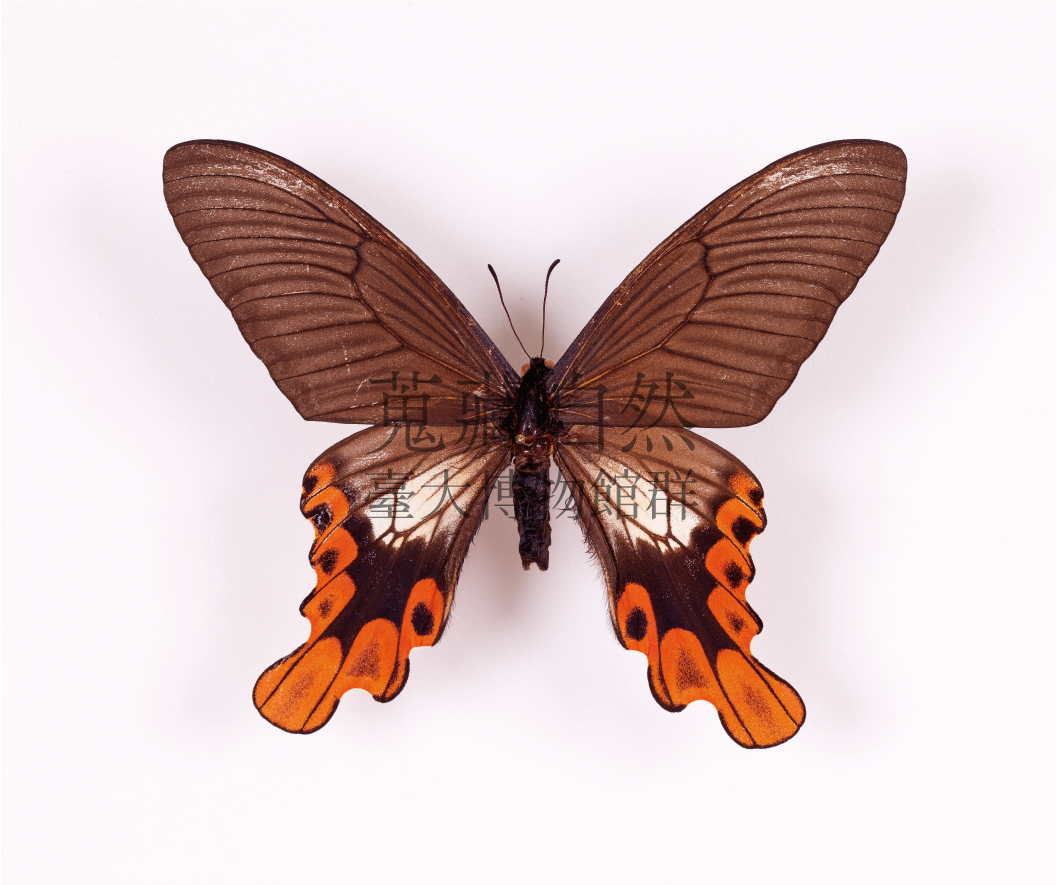
唯一天然紀念物昆蟲:寬尾鳳蝶(Papilio maraho)
The Only Natural Monument Insect: Broad-tailed Butterfly (Papilio maraho)
1932年宜蘭農林學校(今國立宜蘭大學)的教師鈴木利一於學生採集的昆蟲標本中發現此蝶,將標本寄給素木得一教授,請他鑑定種類。翌年,素木帶著他的助手中條道夫ㄧ同赴宜蘭採蝶,在烏帽子山下採到一隻該蝶的雄蝶。1934年素木以鈴木利一寄來的標本為正模標本,與中條所採的標本為副模標本,與楚南仁博一起發表新種。(提供:臺大校史館)
In 1932, Suzuki Toshikazu, a teacher at Giran Agriculture and Forestry College (now National Yilan University), found this butterfly among insect specimens collected by his students. He sent the specimen to Professor Shiraki Tokuichi, asking him to identify the species. The following year, Shiraki and his teaching assistant Chujo Michio went to Yilan to collect the butterfly, and they caught a male one at the foot of Mt. Eboshi. In 1934, Shiraki used the specimen sent by Suzuki as the holotype and the specimen collected by Chujo as the paratype, and published it as a new species together with Sonan Jinhaku.

臺灣博物學會會報:素木博士還曆記念號
Transactions of the Natural History Society of Formosa Special Kanreki Edition Dedicated to Dr. Shiraki
素木得一可謂日治時期的昆蟲學研究之先驅者、開拓者,1920~1926年及 1932~1944年,素木得一兩度擔任臺灣博物學會會長。臺灣博物學會會報在1943年特別為時任會長的素木得一製作素木博士還曆記念號(註:還曆指六十歲),由許多日籍學者撰文介紹素木在植物防檢疫的成就、素木對臺灣昆蟲學界發展的貢獻等內容。
Shiraki Tokuichi is the pioneer in entomological research during the Japanese occupation period. From 1920 to 1926 and 1932 to 1944, he twice served as the President of the Natural History Society of Formosa. In 1943, the Transactions of the Natural History Society of Formosa dedicated a special Kanreki edition for Dr. Shiraki (Note: Kanreki means 60 years old), who was serving as the president. Many Japanese scholars wrote articles to discuss his achievements in pest control and plant quarantine and his contribution to the development of Taiwan's entomological community.
昆蟲相關文物與其研究者
Antique and Researcher

防治害蟲有功的先驅者:素木得一
Pioneer in Pest Control: Shiraki Tokuichi
講座教授素木得一,並不像一般的昆蟲少年一樣從小熱愛昆蟲,而是因緣際會才踏上昆蟲研究之途。素木於札幌農學校松村松年教授的指導下專攻直翅目昆蟲的分類研究。來臺擔任農事試驗場技師後,投入水稻三化螟的調查及防治工作,更透過此研究主題成為日治時期首位以臺灣研究獲得博士學位的學者。素木對臺灣農業害蟲防治研究極具貢獻,引入害蟲天敵澳洲瓢蟲,成功防治吹綿介殼蟲,三年內完全去除蟲害,令人矚目。
Unlike teenagers who are into insects, Chair Professor Shiraki Tokuichi got into insect research by chance. Under the guidance of Professor Matsumura Shonen of Sapporo Agricultural College, Shiraki specialized in the taxonomy of Orthoptera. After coming to Taiwan as a technician at the Agriculture Experimental Station, he devoted himself to the investigation and control of Tryporyza incertulas. He became the first scholar to obtain a doctorate degree in Taiwan studies during the Japanese occupation period. Shiraki made great contributions to the research on agricultural pest control in Taiwan. He successfully kept the population of cottony cushion scale under control by introducing the natural enemy of the pest, Vedalia lady beetle. The pest was completely eliminated within three years, which was outstanding.
小型蛾類專家:一色周知
Expert on Small Moths: Issiki Syuti
小型蛾類專家一色周知於1930年擔任昆蟲學·養蠶學講座助教授,素木得一教授退休後,一色升任教授,二戰後留任成為臺灣大學的教授。一色除了專精於小型蛾類的分類學研究,也奠定臺灣長翅目分類學研究的基礎;對害蟲檢疫、果實蠅防治也有所貢獻。
Issiki Syuti, an expert on small moths, served as an Assistant Professor of the Entomology and Sericulture lecture in 1930. After Shiraki Tokuichi’s retirement, Issiki was promoted to full professor and stayed at National Taiwan University as a professor after the World War II. In addition to specializing in the taxonomic research of small moths, Issiki laid the foundation for the taxonomic research of Mecoptera in Taiwan. He also made contribution towards pest quarantine and fruit fly control.
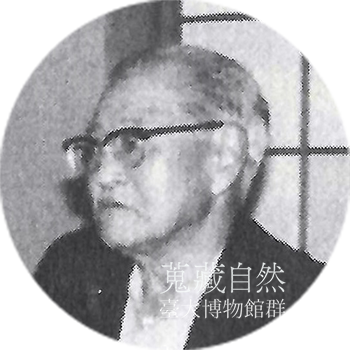
鍬形蟲研究第一人:三輪勇四郎
Expert on Stag Beetles: Miwa Yushiro
大型甲蟲專家三輪勇四郎於1928年擔任昆蟲學·養蠶學講座助手。對臺灣產之甲蟲分類學貢獻甚鉅,如:叩頭蟲、吉丁蟲、鍬形蟲等,1931年發表《臺灣產昆蟲目錄:鞘翅目》,是第一本臺灣甲蟲專書。於農業上研究使用化學防治法防治咖啡、稻作等蟲害問題。1938年引進爪哇閻魔蟲 (Plaesius javanus) 利用害蟲天敵防治香蕉假莖象鼻蟲 (Odoiporus longicollis)。
Miwa Yushiro, an expert on large beetles, served as a teaching assistant of the Entomology and Sericulture lecture in 1928. He made great contributions to the taxonomy of endemic beetles in Taiwan, such as: click beetles, jewel beetles, stag beetles and so on. In 1931, he published "Catalogue of Insects in Taiwan: Coleoptera", which was the first book on Taiwanese beetles. In terms of agriculture, he studied the use of chemicals to control pests of coffee and rice crops. In 1938, he introduced Plaesius javanus as a natural enemy for keeping banana stem borer weevil (Odoiporus longicollis) under control.
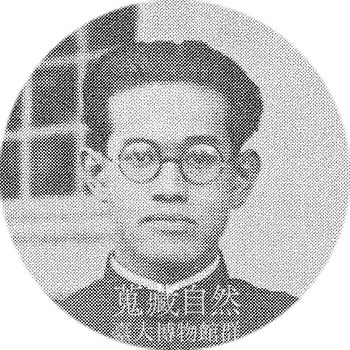
甲蟲、蜻蜓一把抓:中條道夫
Expert on Beetles and Dragonflies: Chujo Michio
中條道夫於1931年於臺北帝國大學農林專門部林學科畢業後,1933年接任臺北帝國大學箕輪重胤的昆蟲學·養蠶學講座助手一職。1936年起被聘任為農林專門部的兼任助教授,並於1942年升等取得教授職位。從事蜻蜓及金花蟲、花蚤、吉丁蟲、擬瓢蟲等臺灣產甲蟲的分類學研究。二戰後返日,至各中學、大學持續任教,曾以日本香川大學「臺灣生物調查團」團長身分返臺兩次。
After graduating from the Department of Forestry, College of Agriculture and Forestry, Taihoku Imperial University in 1931, Chujo Michio took over as the entomology teaching assistant of Minowa Shigetane in 1933. In 1936, he was appointed as an adjunct assistant professor in the College of Agriculture and Forestry, and was promoted to full professor in 1942. He engaged in taxonomic research on dragonflies, as well as endemic beetles such as leaf beetles, tumbling flower beetles, jewel beetles and handsome fungus beetles. He returned to Japan after World War II and continued to teach in various high schools and universities. He returned to Taiwan twice as the head of the “Taiwan Biological Survey Team” of Kagawa University in Japan.

瘴癘之地的曙光,抗瘧顧問:小泉清明
A Ray of Light in Miasma: Koizumi Kiyoaki, Antimalarial Consultant
小泉清明於1929年擔任昆蟲學·養蠶學講座講師,1930年升等為助教授職位。1944年擔任熱帶醫學研究所所長,於臺灣期間主要研究果實蠅、瓜實蠅、蓖麻蠶等昆蟲生理、生態方面的研究,研究領域非常廣泛。擔任熱帶醫學研究所所長期間,協助進行瘧蚊相關試驗,防治瘧疾有功。
Koizumi Kiyoaki served as a lecturer of the Entomology and Sericulture lecture in 1929, and was promoted to assistant professor in 1930. He served as the Director of the Research Institute of Tropical Medicine in 1944. During his time in Taiwan, he mainly studied the physiology and ecology of insects such as fruit flies, melon flies and castor silkworms, covering a broad field of research. During his tenure as the Director of the Research Institute of Tropical Medicine, he assisted in conducting experiments on malarial mosquitos and was successful in preventing malaria.

